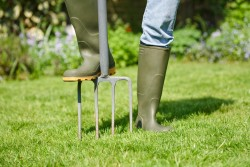It's not easy to pinpoint the problem when areas of your lawn start to go brown or die, but there are ways that you can learn to identify individual problems and the solutions required.
 If you suspect that you might have a white grub infestation, look out for irregular dead spots caused by beetle larvae feeding on grass roots.
If you suspect that you might have a white grub infestation, look out for irregular dead spots caused by beetle larvae feeding on grass roots.Quickly appearing and expanding dead spots can be caused by a number of difficult-to-diagnose lawn diseases or pests.
While most lawn problems can be kept at bay by proper annual maintenance, fertilising and watering, there are additional issues that you may encounter.
Here are some environmentally friendly ways to keep your garden looking good and healthy…
1. White grubs
Adult chafer beetles lay their eggs in the soil and the resultant grubs hatch and feed on underground plant parts.
A large grub population can easily destroy the roots of your lawn, leaving the tops to wither and die.
Where infestation is severe, roots are eaten away to such an extent that the turf can be rolled back like a carpet.
Symptoms
If you suspect that you might have a white grub infestation, look out for irregular dead spots caused by beetle larvae feeding on grass roots. Damage is worst in the autumn.
The dead turf can be easily pulled up like a rug, revealing c-shaped larvae.
 If you own pets, you're probably used to seeing dead spots in the garden, as these are caused by dog or cat urine.
If you own pets, you're probably used to seeing dead spots in the garden, as these are caused by dog or cat urine.Solution
Imidacloprid applied in late spring to early summer is the most effective chemical control for such an issue.
Proper fertilisation and regular watering of the lawn can help to prevent infestation too.
2. Mole crickets
Light brown in colour and up to four centimetres long, the adult mole cricket lays her eggs in the soil in spring and the hatched nymphs feed on the root system of your lawn. If not controlled, the cycle continues and will eventually destroy the grass.
Symptoms
Keep an eye out for brown spots and occasional upturned heaps. When turf is removed, tunnels may be seen in the soil.
Solution
 To avoid a compacted lawn, it is important to perform annual aerating of the lawn. Use a garden fork to 'spike' the entire lawn just before spring.
To avoid a compacted lawn, it is important to perform annual aerating of the lawn. Use a garden fork to 'spike' the entire lawn just before spring.While chemical pesticides are relatively effective, there is a more eco-friendly alternative that comprises dishwashing detergent and water poured into the holes (if you can see them). This needs to be done regularly and, while not a permanent cure, will cut down the population significantly.
3. Lawn caterpillars
Lawn caterpillars like to gnaw away at the grass during the evenings. During the day, they hide between the roots of the grass and they come up to feed on the grass blades at night or on overcast days.
Symptoms
Most active at night, these destructive caterpillars eat the roots and young shoots of lawn, eventually causing it to die off in large, dead patches.
Solution
Check for lawn caterpillars by leaving a damp towel on the grass overnight. In the morning, you should see quite a few caterpillars under the towel.
 When regularly fertilised, watered correctly and maintained properly, a lawn will provide year-round enjoyment.
When regularly fertilised, watered correctly and maintained properly, a lawn will provide year-round enjoyment.Insecticide is sadly the only option. Treat the lawn with Margaret Roberts’ biological caterpillar insecticide, which leaves no harmful toxic residues and does not poison bees, birds or other wildlife.
4. Brown, dry grass
If you’re wondering about reasons for dying grass and how to revive a dead lawn, there are numerous possible causes and no easy answers.
Symptoms
Where parts of the lawn start to dry out and the grass appears to be dead, this could be caused by heavy compacted areas.
Solution
To avoid this, it is important to perform annual aerating of the lawn. Use a garden fork to 'spike' the entire lawn just before spring.
Consider installing stepping stones if this area has regular foot traffic, human or animal.
5. Circular dead spots
If you own pets, you're probably used to seeing these dead spots in the garden, which are caused by dog or cat urine.
Symptoms
These circular patches look like small dead spots which are usually surrounded by lush, dark green grass.
Solution
To keep your lawn looking healthy, try by all means to keep the dogs away from the lawn. Eventually the dead spots will recover, especially if you soak it with a hose.
The best practice is to train your pets to use a particular spot away from the grass like a sand bed or surfaced area that can be easily cleaned.
6. Winter grass
Winter grass is an ugly weed that can easily outgrow and take over your beautiful lawn.
Symptoms
Small clumps of grass that appear on bald spots or lawn edges. Abundant seed heads allow easy dispersion of the grass.
Solution
Manual removal at the first sign of winter grass is the best solution for eradicating this weed. Discard the weeds before moving on to avoid spreading the seeds throughout the garden.
7. Nutsedge
Nutsedges are common weeds that thrive in waterlogged soil. They usually occur when you have poor drainage, frequent irrigation or when the sprinklers are leaking.
Symptoms
If you have this problem, then you’ll note small clumps of grass that appear on bald spots or lawn edges.
The weed’s abundant seed heads allow for easy dispersion of the grass. This plant can easily become rampant in any garden.
Solution
Regular mowing will control the plant by reducing the food source, and the tuber will eventually die off.
If seed bearing plants are trimmed or mowed, collect all clippings and dispose of in a plastic bag to prevent any accidental spreading. Manual removal also assists in preventing the spread.
Annual care and maintenance of lawns
When regularly fertilised, watered correctly and maintained properly, a lawn will provide year-round enjoyment. It is necessary, however, to perform certain tasks annually to maintain a good, healthy growth.
Aerating the soil is important for lush growth and strong root structure, and will assist in a healthy lawn that resists many diseases.
Aerating reduces soil compression and increases water holding capacity of the soil but the process also involves scarifying and removing old thatch (dead grass). This way, the root system can access oxygen, moisture and minerals from the soil, thereby helping in healthy growth of plants.
The best time to aerate the lawn is when it is cool and dry, in late winter or early spring. You can use an ordinary garden fork to aerate a lawn, or cut down on the time spent by investing in a mechanical aerator that does all the hard work for you.
Mechanical aerators have integral spikes mounted on rollers that provide uniform aeration of lawns.








